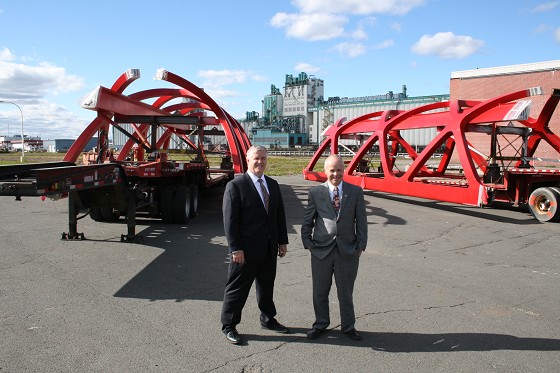Thunder Bay Port Authority Have Concerns About New York Regulations
by Scott A. Sumner
www.thunderbaybusiness.ca
Tim Heney, CEO Thunder Bay Pot Authority and Allister Paterson CEOof Seaway Marine Transport were on hand at an event to talk about several important issues facing the port and the seaway in general. Seaway Marine Transport is the largest operator of bulk cargo ships
on the great lakes and the largest out of Thunder Bay. It is affiliated with Upper Lakes Shipping and Algoma Central Corporation. It runs a dry bulk fleet on the great lakes. Seaway Marine Transport has 27 ships and has been as high as 35 ships at times. Their ships come
to Thunder Bay 175 times per year out of a total 400 total ship movements at the port.

“We load grain to take to Quebec where it is loaded into elevators and transferred to ocean vessels to go international. The business has been reasonably well this season. Last year’s wheat harvest was good so we have had a good year. Next year’s harvest looks a little lower so it will affect us next year. We remain fairly average year by year though,” said Allister Paterson.“We need to renew our fleet and our on the verge of that decision. The world’s ships get built in Asia and so you have to get a great lake ship that is unique at a good price. The government still puts a duty on the import of new ships of 25% so we have to write them a $10 million cheque. The US has also put on a plethora of new regulations in a patchwork which is scaring off investors that will invest in 40 year assets like a ship. The ships are about $40 million plus the tax for a bulker. A self loader would cost $15 million more plus your tax. The challenging part is that the government puts a penalty on bringing in a new green asset. We have had a bi-national waterway for 100 years and in the last few years, the US has changed all that with new
regulations,” said Paterson. “There are two prominent ship building companies in Canada but they cost 50 to 100% more in Canada for our ships. Some of our shipyards can be more competitive on a sophisticated ship like an off shore drilling rig. They don’t want to lose that
business so the governments have kept the duty on.” “ The renewal of the fleet is critical to our future here in Thunder Bay. We partner with Allister to help lobby to get the provincial government involved. We have this meeting each year in Thunder Bay. Thunder Bay is the biggest export port on the Great Lakes. We have a good turnout to our event this year because of our issues of discussion” said Tim Heney. “Coal is up 40% and potash is up 200% at
the Port of Thunder Bay mainly as the economic meltdown last year affected things.
In potash you can only wait 2 years to ship the product so it has helped the Port of Thunder Bay. Thunder Bay is on the only load point on the Great Lakes so it is unique that way.”
Perhaps the most important issue this year for the seaway is the New York ballast regulations, the rules that govern any ship passing through their waters must be equipped with a ballast water treatment system. “The complication of the system is that it is above world standards and doesn’t exist yet. It could shut the seaway down January 1st 2012 just 16 months away. We are trying to raise awareness to get politicians to tell government about the issue,” said Paterson. “A small corner of the seaway passes through the New York area. We have
told them many times about the issue but they say you can apply for an extension. Now they are controlling the seaway from Thunder Bay to Quebec. New York is largely unaffected by that economically. You only put ballast water out when you unload cargo which isn't in New York. It
will have an astronomical effect on Thunder Bay. We are trying to mobilize the Canadian governments to lobby the US. Our company is on the verge of ordering ships and now this is a new complication when if we can’t comply by 2012 our ships will be non compliant. As a Canadian, you can’t do much except talk to your politicians. The US federal government should do the regulations not the States. It could mean the ocean vessels may just decide to not come to Thunder Bay due to the regulations.”
On a positive note the coal and potash movements have been up and project cargo has done well with wind mills and today we have a bridge from Spain going to Calgary said Tim Heney. The Port has had a $200 million impact on the city of Thunder Bay annually and creates $ 8
million in property taxes with 450 direct jobs so it is still a pretty big factor in the economy. In heavy industrials, the port is in the top three and number one as a tax payer.









